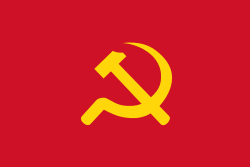Congress of the Lao People's Revolutionary Party
The Congress of the Lao People's Revolutionary Party (LPRP) is the party's highest decision-making body. The LPRP has convened 10 congresses since its foundation in 1955, and eight since taking power in 1975. According to the party rules, the party congress is to be convened by the LPRP Central Committee (CC) every fifth year. It functions as a forum that approves party policy (such as the five-year plans), is empowered to amend the party's charter and program, and elects the Central Committee.[1][2] The party leadership, through the Political Report of the Central Committee, briefs the party on its work in the period since its last congress, and sets out future goals for the period in between the next congress.[3]
 |
|---|
| This article is part of a series on the politics and government of the Lao People's Democratic Republic |
|
Ideology |
| Constitution |
|
|
Legislature
|
|
Executive
|
|
Mass organizations
|
|
|
|
|
The congress has been convened in March since the 5th Congress in 1991. According to Martin Sturt-Fox this suggest an ideological cohesion within the party, and its leadership. The 4th Congress introduced the "New Economic Mechanism" (NEM, market reforms).[1] Partly for introducing NEM, the 4th Congress is the last congress to be postponed due to political infighting.[1] Due to the party's secret nature, it's hard to discern the work and the political intrigues which takes place before the congress.[1] In the run-up to party congresses, outside observers try to discern factional intrigues, usually between two supposedly "pro-Chinese" and "pro-Vietnamese" or "pro-reform" and "anti-reform" camps.[1] Despite this, there seems to be broad agreement within the party on the path its pursuing: that is, creating a socialist market economic model and attracting foreign direct investment.[4]
Keys
| Abbreviations | |
|---|---|
| CC | Central Committee of the Lao People's Revolutionary Party |
| FM | Full member (a member with voting rights). |
| AM | Alternate member (a member without voting rights). |
| Political Report | Political Report to the Central Committee, a document which briefs delegates about the period since the last congress and future work. |
| PMR | Party members represented at the congress by delegates (the party membership at the time). |
Convocations
| Congress | Duration (start—end) |
Delegates | CC elected |
Political Report (presented by) |
PMR |
|---|---|---|---|---|---|
| 1st Congress 1 day None |
22 March 1955 | 25 | 5 | None | ~400 |
| 2nd Congress 4 days 1972 election |
3 February – 6 February 1972 |
125 | 21 FM – 6 AM |
Kaysone Phomvihane | 21,000 |
| 3rd Congress 4 days 1981–1982 election |
27 April – 30 April 1982 |
228 | 49 FM – 6 AM |
Kaysone Phomvihane | 35,000 |
| 4th Congress 3 days 1985–1986 election |
13 November – 15 November 1986 |
300 | 51 FM – 9 AM |
Kaysone Phomvihane | 40,000 |
| 5th Congress 3 days 1990–1991 election |
27 March – 29 March 1991 |
367 | 55 FM – 44 AM |
Kaysone Phomvihane | 60,000 |
| 6th Congress 3 days 1995–1996 election |
18 March – 20 March 1996 |
381 | 49 | Khamtai Siphandon | 78,000 |
| 7th Congress 3 days 2000–2001 election |
12 March – 14 March 2001 |
452 | 53 | Khamtai Siphandon | 100,000 |
| 8th Congress 4 days 2005–2006 election |
18 March – 21 March 2006 |
498 | 55 | Khamtai Siphandon | 148,590 |
| 9th Congress 5 days 2010–2011 election |
17 March – 21 March 2011 |
576 | 61 | Choummaly Sayasone | 191,700 |
| 10th Congress 5 days 2015–2016 election |
18 January – 22 January 2016 |
685 | 69 – 8 AM |
Choummaly Sayasone | 252,879 |
References
General
Information on congresses, number of delegates, number of people elected to CCs, party membership, the individual who presented the Political Report and information on when the congress was convened can be found in these sources:
- "VDO series of party congresses of the Lao People's Revolutionary Party". Vientiane Times. Lao Press in Foreign Languages. Retrieved 7 January 2017.
- "First Party Congress held amid Indochina War". Vientiane Times. Lao Press in Foreign Languages. Retrieved 7 January 2017.
- "Second Party Congress introduces political programme". Vientiane Times. Lao Press in Foreign Languages. Retrieved 7 January 2017.
- "Third Congress adopts first five-year Socio-Economic Development Plan". Vientiane Times. Lao Press in Foreign Languages. Retrieved 7 January 2017.
- "Fourth Party Congress: a milestone in development". Vientiane Times. Lao Press in Foreign Languages. Retrieved 7 January 2017.
- "Fifth Party Congress paves way for improved political system, faster development". Vientiane Times. Lao Press in Foreign Languages. Retrieved 7 January 2017.
- "Sixth Party Congress identifies goals for poverty eradication". Vientiane Times. Lao Press in Foreign Languages. Retrieved 7 January 2017.
- "7th Party Congress targets improved living conditions by 2020". Vientiane Times. Lao Press in Foreign Languages. Retrieved 7 January 2017.
- "Eighth Party Congress resolves to tackles poverty eradication". Vientiane Times. Lao Press in Foreign Languages. Retrieved 7 January 2017.
- "9th Congress re-elects Comrade Choummaly Sayasone as Party Secretary General". Vientiane Times. Lao Press in Foreign Languages. Retrieved 7 January 2017.
- "New Party Central Committee elected". Vientiane Times. Lao Press in Foreign Languages. Retrieved 7 January 2017.
Bibliography
Articles and journals:
- Stuart Fox, Martin (2007). "Laos: Politics in a Single-party state". Southeast Asian Affairs. Institute of Southeast Asian Studies (1): 161–180. JSTOR 27913331.
- Thayer, Carlyle (1983). "Laos in 1982: The Third Congress of the Lao People's Revolutionary Party". Asian Survey. University of California Press. 23 (1): 84–93. doi:10.1525/as.1983.23.1.01p0010v. JSTOR 27913331.
Specific
- Stuart-Fox 2007, p. 161.
- Thayer 1983, p. 89.
- Thayer 1983, p. 85.
- Stuart-Fox 2007, p. 162.
